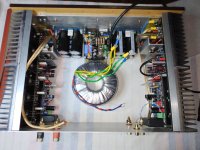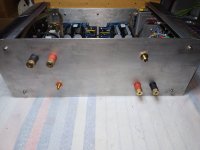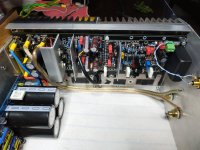Sorry for the confusion. C11 was removed. It was added as a just incase but it was found to be unnecessary so it was removedvalue of C11
Couldn't wait on the wiring vid of Daniel. Amp appears to be working nicely. Psu cables twisted and covered, not plaited. Input wires not so neat yet but it sure does sound very good. Don't have the fancy measuring equipment of course but I can't hear any hiss or hum with my ear right next to the tweeter.
Special thx to Stuart who kept me on the right path along the way. Took me 5 months... 1 month less then planned🙂

Special thx to Stuart who kept me on the right path along the way. Took me 5 months... 1 month less then planned🙂
I like your back panel orientation of inputs and outputs. You can turn it anyway and it will still be symmetrical.
My wolverine was quickly put on hold due to life's demands but I assure you it is not mothballed - I have been lurking and just stopping in to say I am in awe of what this amplifier is capable of. It would appear, at least to me, to be one of the best if not the best possible class AB amplifiers one could possibly design. Simply amazing team, and everyone's builds so far are really, really pro. I cannot believe the BOM and build guide. just amazing.
Its really nice to see some positive feedback and comments appear in this thread, Thanks Guys 🙏
Output AC and DC measurments.
After initial tests, adjustments and some playing completed I noticed the following.
DC offset fluctuates between -0.2 mv and +0.2 mv sometimes hitting +/- 0.5 mv.
AC output no load: With inputs shorted pretty much 0.00 mv occasionaly hitting 0.03 mv. With inputs NOT shorted its more or less stable around 4.5 mv.
LTP after fully warmed up stays stable at 5.00 V.
Is the above pretty much in the ballpark or should i do some more or other tests?
Input cabling
Any specific preferences on the input cable type or doesn't that really matter? Ie: coax or twisted pair?
thx
willem
After initial tests, adjustments and some playing completed I noticed the following.
DC offset fluctuates between -0.2 mv and +0.2 mv sometimes hitting +/- 0.5 mv.
AC output no load: With inputs shorted pretty much 0.00 mv occasionaly hitting 0.03 mv. With inputs NOT shorted its more or less stable around 4.5 mv.
LTP after fully warmed up stays stable at 5.00 V.
Is the above pretty much in the ballpark or should i do some more or other tests?
Input cabling
Any specific preferences on the input cable type or doesn't that really matter? Ie: coax or twisted pair?
thx
willem
@wkloppen your offset measurements are fine. The offset tends to drift around 0, which means some time it is negative and sometimes positive. It moves a bit with temperature, but once you set it with the circuit at operating temperature, it should then stay near 0.
As for the AC output with shorted input, whether you can get a useful measurement depends on your voltmeter. I have two Rigol meters, and both show 000.0000 or 000.000 mV across the output. However, it turns out the true minimum measurement for those meters is somewhere above 300 uV. Measuring with my Keithley DMM 6500, I find that there is indeed some noise, but it is well less than 100 uV. However, note that even the higher-end DMMs from Keithley and Keysight all specify +/- 20-60 uV AC accuracy. This includes the 8.5 digit offerings. Not until you get to the Keysight $15,000 meter is there any improvement in the AC measurement accuracy. And, buried in the notes, is the caveat that the accuracy specs only hold for inputs > 1% full-scale, or perhaps 10% full-scale.
I was really impressed when I got the original 000.0000 reading after checking the DC offset and switching to AC. I was also suspicious, as I know nothing is that perfect. The adage about getting what you pay for seems to hold in most test equipment. I just wish that linear performance improvements didn't come with exponential price increases.
As for the AC output with shorted input, whether you can get a useful measurement depends on your voltmeter. I have two Rigol meters, and both show 000.0000 or 000.000 mV across the output. However, it turns out the true minimum measurement for those meters is somewhere above 300 uV. Measuring with my Keithley DMM 6500, I find that there is indeed some noise, but it is well less than 100 uV. However, note that even the higher-end DMMs from Keithley and Keysight all specify +/- 20-60 uV AC accuracy. This includes the 8.5 digit offerings. Not until you get to the Keysight $15,000 meter is there any improvement in the AC measurement accuracy. And, buried in the notes, is the caveat that the accuracy specs only hold for inputs > 1% full-scale, or perhaps 10% full-scale.
I was really impressed when I got the original 000.0000 reading after checking the DC offset and switching to AC. I was also suspicious, as I know nothing is that perfect. The adage about getting what you pay for seems to hold in most test equipment. I just wish that linear performance improvements didn't come with exponential price increases.
Well done Willem,Couldn't wait on the wiring vid of Daniel. Amp appears to be working nicely. Psu cables twisted and covered, not plaited. Input wires not so neat yet but it sure does sound very good. Don't have the fancy measuring equipment of course but I can't hear any hiss or hum with my ear right next to the tweeter.
Special thx to Stuart who kept me on the right path along the way. Took me 5 months... 1 month less then planned🙂
View attachment 1190049
Great to see your amplifier is working
That is a nice set of speakers you have there by the way.
-Dan
Or shielded-twisted or just shielded?Input cabling
Any specific preferences on the input cable type or doesn't that really matter? Ie: coax or twisted pair?
PSU power DC
I also noticed after several hours of being switched on and bias finetuning, the PSU DC has dropped a bit from 57.7x to 57.0x volt. What would be the explanation of that? Does that have to do with burning in the various capacitors allong the way?
thx
reg
Willem
Probably due to variation in mains voltage.
Improvement suggestions,
With the amp effectively finished besides some cabling and assembly activities, I've fallen into a dead zone more or less. In other words... whats next?... Any improvement suggestions more then welcome...
Furthemore, as many others did before me, I'd like to thank the Wolverine design team including the frontrunners for the tremendous support I've received. I'm a beginner and have learnt a lot and thank it worked out nicely.......
regards
Willem
With the amp effectively finished besides some cabling and assembly activities, I've fallen into a dead zone more or less. In other words... whats next?... Any improvement suggestions more then welcome...
Furthemore, as many others did before me, I'd like to thank the Wolverine design team including the frontrunners for the tremendous support I've received. I'm a beginner and have learnt a lot and thank it worked out nicely.......
regards
Willem
Ok finally, as promised, please find the "Wiring your amplifier" video linked below.
Sorry for the delay on this one, unfortunately I am sick with Covid.....
Please enjoy the video 🙂
I hope this information helps someone
- Dan
Sorry for the delay on this one, unfortunately I am sick with Covid.....
Please enjoy the video 🙂
I hope this information helps someone
- Dan
"Wiring your amplifier"
I wanted to express my sincere appreciation for the incredible video @danieljw shared with us. It is truly a masterpiece, both in terms of its professional quality and the abundance of valuable information it provides for all amplifier builders.
The amount of effort and dedication that went into creating this video is truly commendable. It's evident that the Daniel took his time to ensure that each and every detail was thoroughly explained, leaving no room for confusion.
I have no doubt that this video will become an invaluable resource for our community. Its informative content covers a wide range of topics that are relevant to amplifier builders of all levels of experience.
The video has undoubtedly raised the bar for the quality of content within our community, inspiring us all to strive for excellence in our own projects.
I am genuinely grateful that this video was created and I have no doubt that it will revisit it numerous times in the future.
Thank you once again for your incredible contribution to our DiyAudio community!
- Home
- Amplifiers
- Solid State
- DIY Class A/B Amp The "Wolverine" build thread


